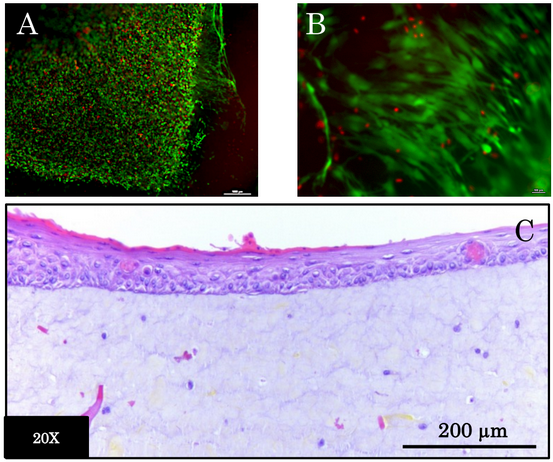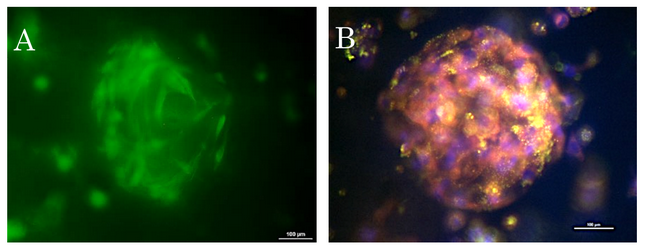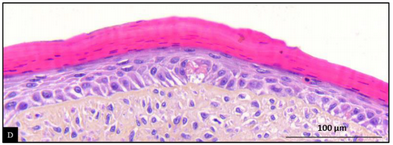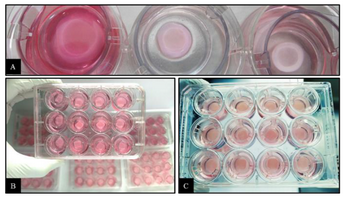Cell therapy research startup CTIBiotech has unveiled two bioprinted full skin model technologies for skincare applications. Focused on providing researchers with the best tools to make the most human-compatible products, the French-based company presented the first bioprinted immune skin model suitable for screening drugs and ingredients for normal and inflamed skin, as well as a 3D printed sebaceous gland model for oil secretion screening and burns research.
3D bioprinting technologies developed at CTIBiotech are expected to enable researchers to reproducibly create predictive human tissue models in large quantities and advance biomedical research. Moreover, regulations and consumer requirements for skin products have increased in the pharmaceutical and cosmetic fields, making fast, reliable, and safe testing a priority. The company’s latest innovations in bioprinting are expected to help accelerate the creation of skin models, which have been historically considered a laborious manual task.
The company’s two new bioprinted full skin model technologies were unveiled at Japan’s 31st International Federation of Societies of Cosmetic Chemists (IFSCC) Congress, which, like most events in 2020, turned virtual due to the ongoing COVID-19 pandemic. CTIBiotech has been working for five years to refine its bioprinting expertise to produce new models for skincare applications, meeting a recurring need for tests to evaluate the efficacy and safety of ingredients contained in dermato-cosmetic products, as well as medical and aesthetic devices or the preparation of clinical trials for skin regeneration and burns.

Artificial human skins produced by 3D bioprinting and matured over several weeks. Image courtesy of CTIBiotech
Researchers from CTIBiotech and German dermatological research laboratory Beiersdorf developed an innovative in vitro full skin model including sebaceous glands, using bioprinting technology to investigate lipid production and high throughput screening of active ingredients. These innovative, cost-effective and useful models could become a powerful tool used to develop advanced cosmetic and dermatological products in the near future.
Sebaceous glands secrete a mixture of lipids to lubricate the skin, making them one of the first defensive mechanisms against external aggressions, also contributing to regulating skin microbiome, have antioxidant properties and anti-aging characteristics. Nico Forraz, Co-founder and CEO of CTIBiotech, told 3DPrint.com that Beiersdorf needed to access technology that would allow rapid screening of new products or ingredients, but at the same time could be advanced and sophisticated enough to help its researchers investigate new products that could boost or reduce sebum production.

3D bioprinted skin models with bioink and primary CTIBiotech cells. A) and B) Viability assay using Live/Dead reagent after 8 days, C) 21 days after 3D Bioprinting. Image courtesy of CTIBiotech
The need for rapid and accurate human sebaceous screening is very important, particularly due to an increase in global pollution and a rise in allergic skin incidences. CTIBiotech designed a rapid process to harvest, from donors, skin samples which can be used to grow out cell populations. Then, by adapting human cell bioprinting strategies to design printed skin models both on the macro- and micro-scale, the researchers managed to create a multi-gland micro-sebaceous full skin model with the epidermis, dermis, and sebaceous glands, for rapid screening of ingredients and medications.
Screening on this scale allows faster selection of both the right product and the concentration of the product which will be useful for skin treatments. The 3D model was designed using CAD software, and then bioprinted with Cellink’s Bio X 3D system in 12-well plates. After that, the printed models were matured over a 21-day period. CTIBiotech was able to 3D print more than one hundred reproducible skin models within two hours. The company claimed that the 3D model provides more pathological and real-time data on the effect of an ingredient on the skin, allowing a better and more targeted selection of cosmetics and drugs for customers. In fact, Forraz said that they are actively working on sebaceous gland models for acne and burns.
“There are very few effective drugs against acne, and many pharmaceutical companies looking to launch anti-acne programs. Similarly, there is a need for drugs that can help with moisturizing actions for burn victims. Any drug that needs to address this condition, can be modeled on the bioprinted skin models we make,” suggested Forraz.
The second skin model developed by CTIBiotech is a bioprinted immunized mature macrophage-based full skin in vitro testing system for screening cosmetic ingredients designed either to reduce inflammation or prevent it. Macrophages were chosen in this study because of their extreme importance in the immunological kinetics of the skin, these specialized cells are the first line of defense in the body, and can detect and destruct bacteria and other harmful foreign organisms.
This time, the company build the model in partnership with French cosmetic chemical additive manufacturer BASF Care Creations, which wanted a reliable model to target specific ingredients for skincare that can reduce inflammation in the skin. Forraz indicated that companies like BASF need to predict the efficacy and safety of skincare products early on. There is a growing need for solutions to prevent and treat non-fatal skin disease but the availability of suitable and affordable screening systems is not keeping up. CTIBiotech has detected an increase in demand for more complex ex vivo skin models and in vitro testing due to safety concerns and regulations.
In order to create the immunized skin models, the bioprinted models were designed and sliced beforehand on the computer using SketchUp and Slic3r software respectively in order to generate a G-code file. Then, amplified cells were separately mixed with a bioink suitable for skin development and 3D printed with Cellink’s Bio X device in 12-well plates. More than a hundred identical skin models were 3D printed within two hours. This screening system is human-orientated and was challenged with key molecules of irritation to evaluate the efficacy of the model for useful data acquisition.
Partnerships helped the CTIBiotech researchers understand the end-user perspective and fast-track their skin models, which are now being commercialized by the company. BASF and Beiersdorf were the first two companies to use the models, but Forraz confirmed that they are now testing bioprinted models for many more businesses and even clinical hospitals in Paris.
“The idea is to bioprint a human tissue that is as close to the human condition as possible with applications for cosmetics, dermatology, and hospital therapeutics. We are interested in continually developing our skin models and cancer models, but moving forward in the longterm, we are already looking to develop bioprinted models for scalp skin and skin pigmentation, and even trying to integrate neurons into our skin models, to create sensitive skin models (but that is still in the works),” went on Forraz.
Thanks to bioprinting, CTIBiotech is transforming its business by innovating in the automation of the development and production process of human tissue models. These new models, produced in multiple copies and biologically identical to the patient’s own tissue, will be powerful gas pedals for research and development of, for example, new anti-cancer drugs or more effective skincare.
Subscribe to Our Email Newsletter
Stay up-to-date on all the latest news from the 3D printing industry and receive information and offers from third party vendors.
Print Services
Upload your 3D Models and get them printed quickly and efficiently.
You May Also Like
Reinventing Reindustrialization: Why NAVWAR Project Manager Spencer Koroly Invented a Made-in-America 3D Printer
It has become virtually impossible to regularly follow additive manufacturing (AM) industry news and not stumble across the term “defense industrial base” (DIB), a concept encompassing all the many diverse...
Inside The Barnes Global Advisors’ Vision for a Stronger AM Ecosystem
As additive manufacturing (AM) continues to revolutionize the industrial landscape, Pittsburgh-based consultancy The Barnes Global Advisors (TBGA) is helping shape what that future looks like. As the largest independent AM...
Ruggedized: How USMC Innovation Officer Matt Pine Navigates 3D Printing in the Military
Disclaimer: Matt Pine’s views are not the views of the Department of Defense nor the U.S. Marine Corps Throughout this decade thus far, the military’s adoption of additive manufacturing (AM)...
U.S. Congress Calls Out 3D Printing in Proposal for Commercial Reserve Manufacturing Network
Last week, the U.S. House of Representatives’ Appropriations Committee moved the FY 2026 defense bill forward to the House floor. Included in the legislation is a $131 million proposal for...




































